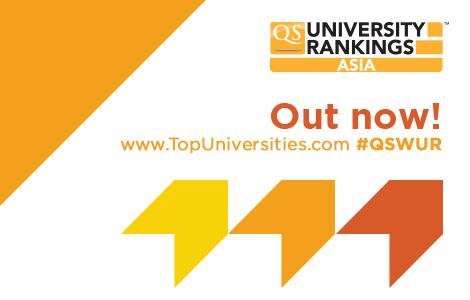
The fifth edition of the QS Asian University Rankings was launched at a packed conference in Beijing on June 10. Held at Peking University, seventh in the ranking and the top university in mainland China, the event was addressed by Li Yansong, vice president of PKU, and attracted over 150 delegates from across China.
They heard that the mainland’s top two institutions, Peking and its neighbour Tsinghua, are ranked seventh and eleventh in Asia. They both had a near-perfect score in our academic and employer surveys, which account for 40 per cent of each institution’s possible score.
However, Asia’s top university in our ranking is the National University of Singapore (NUS), unchanged from 2014. In second place is the University of Hong Kong, up from third in 2014. It has swopped places this year with KAIST in Korea, which is now third.
The top ten universities we show here include four from Hong Kong (HKU, Hong Kong University of Science and Technology, Chinese University of Hong Kong and City University of Hong Kong), three from Korea (KAIST, Seoul National and POSTECH), two from Singapore (NUS and Nanyang Technological University), plus PKU from mainland China. As well as being from a geographically limited set of nations, this group of institutions includes four with a special mission as science and technology universities.
The picture changes a little in positions 11-20, where there are five Japanese universities as well as Tsinghua and Fudan from mainland China, along with three more Korean institutions.
These rankings also confirm the continuing modest performance of Indian higher education on the regional and global stage. Best-placed is the Indian Institute of Technology Bangalore, in 34th place. It is a new entrant in the light of the recognition by QS that it teaches a broad enough range of subjects not to be viewed as a specialist institution. Of the 19 Indian institutions that we ranked in both 2014 and 2015, 17 have fallen this year.
These rankings use some of the same measures as the World University Rankings, including data from our global academic and employer surveys, plus material on faculty/student ratio and on international students and faculty. The other measures we use, including publications volume, citation per paper and exchange student numbers, have been adopted in the light of discussions in the region.
The results suggest that potential students at Asian universities might not always want to concentrate their attention on the most prestigious institutions. Only one of our top 10, POSTECH in Korea, is also in the top 10 for faculty/student ratio. Senior faculty in such institutions are expected to be highly productive of research. The result could be that students end up in big classes taught by junior staff.
? One questioner at the Beijing event asked the most difficult question ever about university rankings. How can we give her university credit for the excellent research it carries out, which is largely funded by the Chinese military and is never published? The answer? We can’t possibly gauge research which generates no citations and no scholarly impact. Our advice is for the university in question to arrange for a public version of its work to be appear in the academic literature, as happens in the US and Europe in similar cases.



